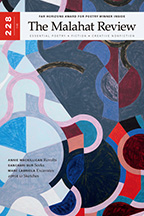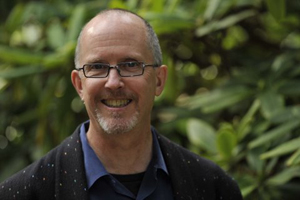Al Purdy and Earle Birney Before Email: John Barton in Conversation with Nicholas Bradley

Malahat editor John Barton talks to Nicholas Bradley about the edition of the forty-year correspondence between iconic Canadian poets Al Purdy and Earle Birney that he has edited for publication with Harbour Publishing in 2014. A small sample of Purdy and Birney’s letters appears in the Winter 2013 issue of The Malahat Review.
Nicholas Bradley is an assistant professor in the Department of English at the University of Victoria. He teaches Canadian and American literature with an emphasis on contemporary writers from the west coast. His past contributions to The Malahat Review include several book reviews, and an essay on the legacy of Robin Skelton and Charles Lillard in #160 (Autumn 2007).
What drew you to editing the correspondence of Al Purdy and Earle Birney? Can you give us a sense of how many letters they exchanged, over what time period, and what their areas of concern were?
Letters are a strange genre—they begin as private documents and sometimes come to have a public life. But good writers are good writers, and poets’ letters are almost always interesting. They often shed light on published poems and they are an essential source of biographical material. I have great admiration for Birney’s poetry and Purdy’s. Editing the letters appealed to me as a way of providing a context for the poems. But I didn’t realize until I had started the project that the scale of their correspondence was so great. The poets wrote hundreds of letters to each other in a period of roughly forty years—from the late 1940s through the 1980s. There were times when they did not correspond very often, but for decades they wrote to each other with remarkable consistency. It’s difficult to say precisely how many letters were exchanged. Not all of the extant letters have been catalogued and I assume that some letters have not survived.
Birney and Purdy touched on every subject imaginable in their letters, but they turned again and again to certain topics: the difficulty of writing well, travel as a source of inspiration, the state of Canadian literature, the great poets whose works were truly worth reading. Birney was a lifelong academic and his letters were full of complaints about the university—about bureaucracy, his loathsome colleagues, the wasted time that could have been spent writing poems. After a certain point in his life Purdy didn’t have a day job, so his letters passed on a different kind of news. He wrote about repairs to his house, his wine-making, income tax—the trivial things that make up daily life. Both men were frequent travelers, and so there was nearly always news of recent or upcoming trips to pass on. They helped each other with applications for the grants that made their travels possible. The letters were often intimate. Purdy in particular was often quite candid in expressing his dissatisfactions and even his despair. The writing life was not always a happy one.
As evidenced in the letters, how did the nature of their relationship change over the years? Did each say one thing to the other and something else about him behind his back? Did they meet often face to face or were letters their principal method of communication?
They saw each other in person fairly regularly, but letters were their primary way of keeping in touch. When Birney lived in Vancouver and Purdy lived in Ameliasburgh, they could only visit each other on occasion. But even when Birney lived in Toronto, they relied on letters. Long-distance phone calls eventually became more practical. Some letters were answered by phone, a result of which is that both sides of a conversation do not always exist on paper. For literary matters, though, letters remained important. The poets stayed in the habit of setting down on paper their thoughts about the other’s writing.
The relationship did change as time went on. When they began to write to each other, Purdy was essentially a novice poet. In the late 1940s Birney was the editor of Canadian Poetry Magazine. Purdy wrote to him, trying to get his work published and trying to learn how to write in a contemporary style. Birney’s poetry was a model for him to emulate. But in time, Purdy came to see Birney’s poetry—and his own—with some perspective. In the end, Purdy thought that Birney was “a very fine poet” but not “a great poet.” He saw clearly what each of them had achieved during their careers, and he felt, I think, that their accomplishments were not adequately recognized. There is a real sadness in some of the later letters as the poets lament what they perceived as their lack of readers and their waning reputations. But there were no great betrayals. They irritated each other now and then, as friends do, but they were devoted to each other.
With regard to the three poems—Birney’s “Fall by Fury” and Purdy’s “The North West Passage” and “Beat Joe McLeod”— discussed in the letters excerpted in The Malahat Review, is it apparent from the versions they finally published in magazines and/or in book form that they seriously considered one another’s comments? Was either poet very open to suggestions about his work?
Both poets had strong opinions about how poems should sound, and about what made a poem successful. I don’t think that they made changes to their poems lightly. But they did typically revise their works heavily, and the opinions that they received from each other contributed to the process of revision. In some cases, it is possible to see that Purdy changed a word, say, on Birney’s recommendation, but in general each poet used the other as a sounding board. Purdy was usually more willing to share drafts and to take advice. In this regard Birney remained the senior figure, the adviser rather than the one advised.
“The North West Passage” was very different, when it was published in Wild Grape Wine, from the version of the poem in Purdy’s letters to Birney. It’s difficult to say with certainty whether Purdy made changes because of Birney’s suggestions or for other reasons. He took Birney’s opinions seriously, though, and consultation was an essential part of his taking a poem from draft to published version. He listened to Birney carefully, although at times he disregarded his friend’s advice. For much of their relationship, the dialogue between the poets was one of peers. Each author knew that he knew how to write a poem that “worked,” but the other’s opinion was one way of finding out whether the poem was not just acceptable but meaningful.
I recently read in a New Yorker review of a new biography of Norman Mailer that over his lifetime he published 45,000 letters. While I can’t imagine that either Birney or Purdy managed to crank out that many each themselves, were they both prolific letter writers to an eclectic set of recipients? What do you think moved them to pick up their pens so regularly and lick an endless stream of stamps?
They had no choice. In the 1940s and 1950s and even later, Canada had a relatively small population of serious writers. Writing letters was a necessity; there could not have been a national community of writers otherwise. Letters helped make Canadian literature an institution. Birney and Purdy travelled widely in Canada, and developed a national network of literary friends and acquaintances. Purdy seems to have written to every writer in Canada at some point. Birney had many international contacts as well. His archives contain letters from writers from around the globe.
I don’t know how many letters Birney and Purdy wrote during their lifetimes. But there are boxes upon boxes of letters in their archives. They must have spent hours at the typewriter each day.
From my figuring, We Go Far Back in Time will be the fourth collection of Purdy’s correspondence with another writer; the previous three are with Charles Bukowski, George Woodcock, and Margaret Laurence. Are you familiar with these other collections? Does this new volume differ from them in any way? Does Purdy reveal a different side of himself in his correspondence with Earle Birney in comparison to the Purdy we would meet in the other collected letters?
There is also the volume of Purdy’s collected letters, Yours, Al. That book, edited by Sam Solecki, the leading Purdy scholar, is over 500 pages long, but in fact it contains only a fraction of the letters that Purdy wrote. He produced so many letters that any selection is bound to give a slightly different view of the author and his life. The same holds true for Birney. Until multi-volume editions of their correspondence are published—time will tell whether readers and scholars feel that such editions are necessary—every collection will provide only a partial account of each author’s epistolary life.
The correspondence between Birney and Purdy is in part a discussion between poets about matters of professional concern and in part a conversation between friends. The friendship was very important to both men. Purdy once wrote that one of Birney’s poems was “the record of a friendship and as such is worthwhile in that area alone.” Something similar could be said of the letters between Purdy and Birney.
To draw attention to the excerpt of these letters in The Malahat Review, one of the cutlines on the Winter 2013 issue’s cover is “Birney and Purdy Before Email.” Editions of collected letters have long been a venerable preoccupation of literary scholars, but with the increasing reliance on email and social media over the last two-plus decades, what, if anything, will be available to collect? Do you envision that your academic peers might one day compile the Selected Gmails of Douglas Coupland, say, or the Collected Tweets of Margaret Atwood?— if we’re lucky, the latter might read like the aphorisms of Rochefoucauld! Are the hazards of documenting the digital correspondence habits of today’s authors something present-day critics discuss and/or lament? What are your own thoughts?
Twitter is different from email because the messages are public in the first instance. I’m sure that Atwood’s tweets will eventually be collected. Her email would be more interesting to read, I think, and more difficult to publish—both for technical reasons, and because email is essentially a private medium. Future editors will have the challenge of finding the messages of literary significance in a writer’s inbox among all of the inconsequential messages that everyone sends and receives. Any critic would love to have access to a writer’s email, but separating the digital letters of value from the digital detritus would be a huge labour. It usually takes more effort to write and mail a letter than it does to send an email. But this is not to say that every letter that Birney or Purdy penned is an immortal work of literary genius. There are plenty of off-colour remarks and lewd anecdotes in the correspondence as well as illuminating commentary on poems. The letters are enjoyable to read as a result, but they require a certain ear for tone.
If we allow that there is a connection between a work of art and the life of the artist, then any document from that life has the potential to illuminate the work. Some critics will favour theoretical approaches over biographical and historical approaches, but in my opinion all documentary materials are valuable. Who knows what use some ingenious critic will one day make of the Birney-Purdy letters or Atwood’s tweets or Ondaatje’s grocery lists?
In your introduction to We Go Far Back in Time, you make reference to Auden’s ambivalence about publishing writers’ correspondence because it makes public many things that they have preferred were left private. He allows the letters’ “historical significance” to be an exception. Because you have taken the trouble to immerse yourself in Purdy’s and Birney’s correspondence, to have it transcribed, and to prepare it for a present and future readership, you must believe that they have lasting import. How would you summarize their significance, and what in particular do you think they would have to say to beginning writers who might have first encountered Birney’s “David” or Purdy’s “The Country North of Belleville” in an English class either in high school or the first year of their undergraduate studies?
The letters, in my opinion, are essential reading for anyone who is interested in the poetry and in the creation of what today we recognize as Canadian literature. They provide context for many poems, contain notes and drafts, and give important biographical details. So the letters will be historically important as long as readers remain interested in the authors’ works. The letters are also important because they give a sense of how difficult it was to be an author in Canada in the postwar period. Birney and Purdy were lucky to find in the other a dedicated reader who was tough but encouraging, sympathetic but rigorous.
Beginning writers may be struck by the struggles that Birney and Purdy faced in establishing themselves as writers. Learning to write well, finding a distinctive style, publishing poems and books, earning a living from poetry—none of these came easily. Birney and Purdy were talented writers, to be sure, but they were also persistent. And all readers, whether or not they are writers themselves, may be struck by the very human portraits that the letters create. The poets were complex, contradictory figures.
Edited collections of letters are invaluable scholarly resources, but they inevitably give a slightly misleading sense of an author’s correspondence. They clean it up and distill it. When you see Purdy’s papers at Queen’s University or Birney’s papers at the University of Toronto, you quickly appreciate the nearly chaotic aspect of their correspondence. There are boxes and boxes of letters, some sorted and many unsorted. Birney and Purdy wrote and wrote and wrote—to everyone, it seems. If there was going to be a Canadian literature, it had to be sustained by the authors themselves. And so an enormous quantity of letters crisscrossed the country, linking writers in distant places. For better or worse, that era and that phenomenon have come to an end.
* * * * * * * *










